When I read the Ivy Style book, I noticed a few ads from the 1930’s and since I have a large men’s clothing magazine & picture archive from that time period, I wanted to share a few of these vintage 1930s fashion ads with you today.
First of all, the way magazine ads used to be produced was quite different from today. Most fashion ad campaign nowadays have a specific theme and so you will see the same models in the same poses in the same pictures – or at least similar one’s – in various publications around the globe. Back in the day, photography was rarely the preferred choice for advertising because colored fashion illustrations were able to express a very different, often more debonair feel. Today, brands provide their own images, but back in the thirties, it was quite common to have the fashion illustrator of the magazines actually create the ads of their clients. Therefore some of the ads were actually drawn by the likes of Laurence Fellowes, Leslie Saalburg or Lester Rubin.
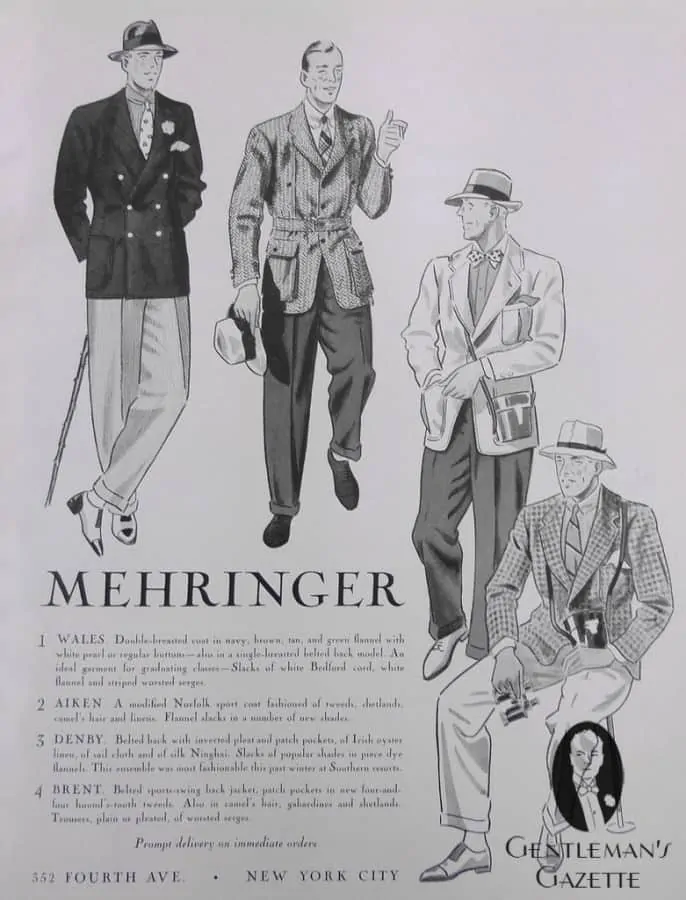
Forgotten Brands
None of the brands that were advertised in these thirties fashion magazines do exist any longer, but they produced interesting stuff, so let’s take a look:
Mehringer
Mehringer was located on 352 Fourth Ave in New York City and provided elegant men’s clothing and dressing gowns.
The gent on the very left wore a double breasted coat which was available in navy, brown, tan and green flannel with white mother of pearl or horn buttons. Alternatively it was available as a single breasted coat with belted back. The slacks were either made of white Bedford cord, white flannel or striped worsted serges. In the ad, it is noted that this ensemble would be ideal for graduating classes. In the thirties, the Ivy League universities were the forerunners in men’s fashion and so every clothes manufacturer seemed particularly keen to gather their attention.
The chap to his right wore a Norfolk jacket which was available in tweed, shetlands, camel hair and linen. The slacks were made of flannel and available in various colors.
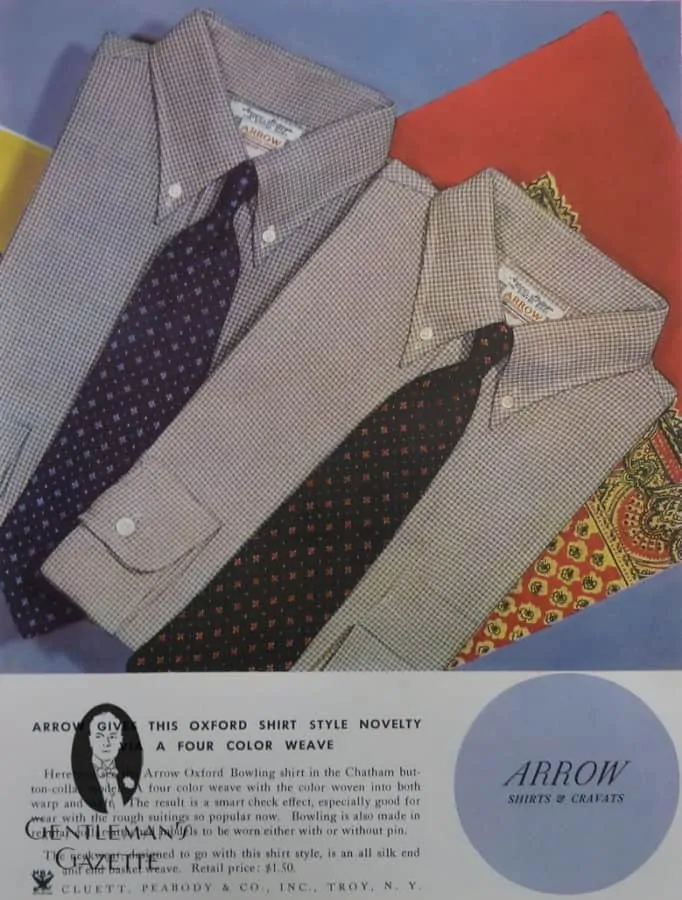
The second gentleman from the right shows off a light colored jacket with inverted back pleat, patch pockets and heavy contrast pick stitching, which is very similar to a modern jacket I own.
Finally, there is a man wearing a combination of houndstooth tweeds with plain front or pleated worsted serge trousers.
Arrow, Manhatten & University Shirts
The Oxford Button Down Collar Shirt – often also referred to as OCBD for Oxford Cloth Button Down – was a very popular item in the Ivy Style wardrobe. In this ad by Arrow, one of the leading shirt manufacturers of the time, they advertise “ARROW GIVES THIS OXFORD SHIRT STYLE NOVELTY VIA A FOUR COLOR WEAVE.”
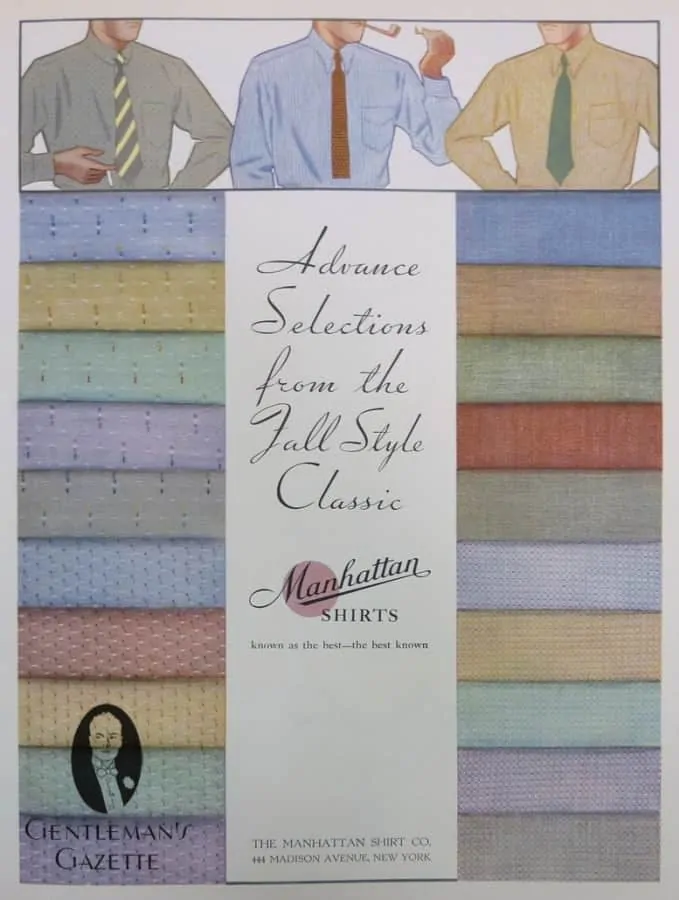
Basically, they added colored yarns to warp and weft in order to create a smart check effect that was “especially good for wear with the rough suitings so popular now”. The styles were tailored to be worn with or without collar pin. The ties are silk in a end and end basket weave. Retail price per shirt: $1,50.
Manhatten Shirts from 444 Madison Ave NYC offered a great selection of fall style shirts fabrics in various colors in 1934. Just compare these fabrics to the current selections ranging from white over blue to maybe pink, and you will quickly realize that there is much less diversity nowadays.
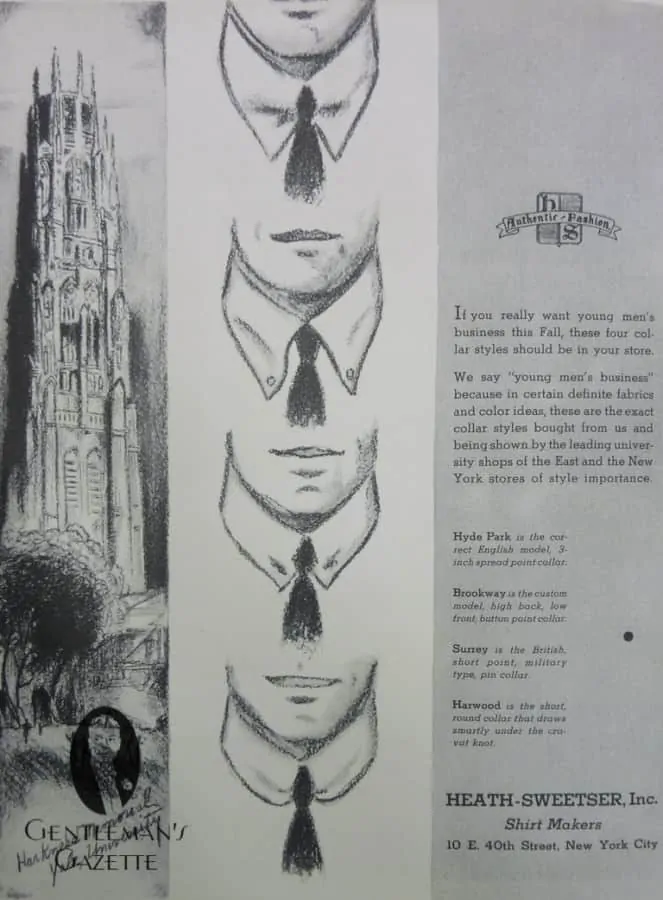
As outlined before, Ivy League schools were the way to go for purveyors of clothing, and the following ad by Heath-Sweetser, Inc. Shirt Makers is a perfect example for that. They chose a collegiate inspired logo that reads “Authentic – Fashion” and below it is explained that these four collar styles are shown “by the leading university shops of the east and the New York stores of style importance”. On the left, you can see a sketch of Harkness Tower at Yale University and in the middle four popular collar styles. On top, the “correct English model”, followed by the button down “custom model” with high back and low front. Then there is the British short point collar and the short, round club collar. Note, three out of 4 collar are worn with collar pins.
Dobbs & College Style Hats
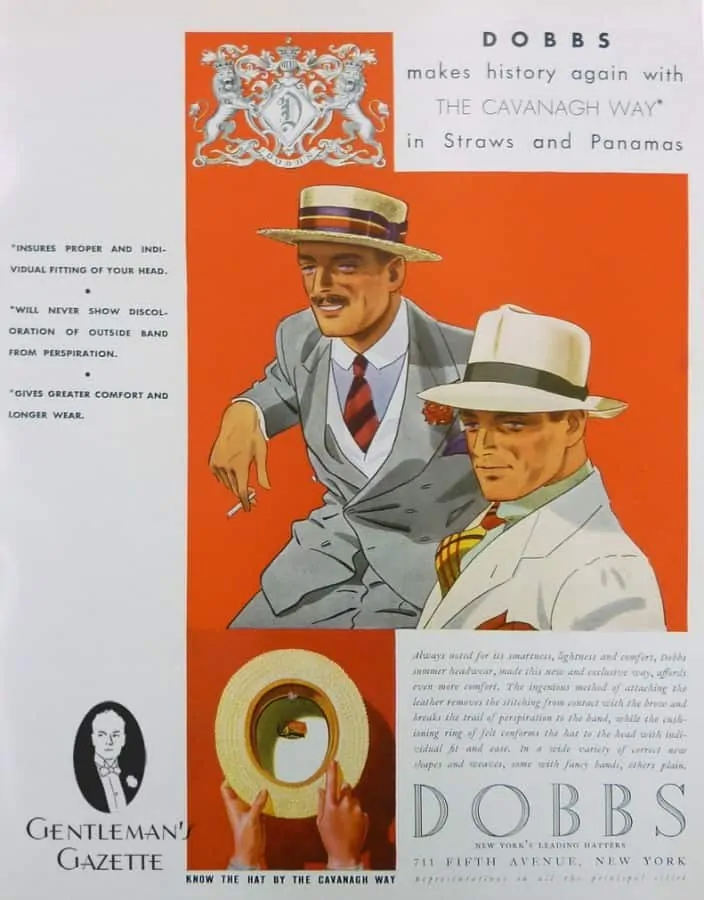
Of course, headwear was of much greater importance than it is today and DOBBS of 711 Fifth Ave in in New York introduced their new hat models. In this ad, Dobbs tried to advertise their “ingenious method” of attaching the leather created a barrier between the sweatband and outer band. As a consequence they promised that there will never be any discoloration of the outside band from perspiration.
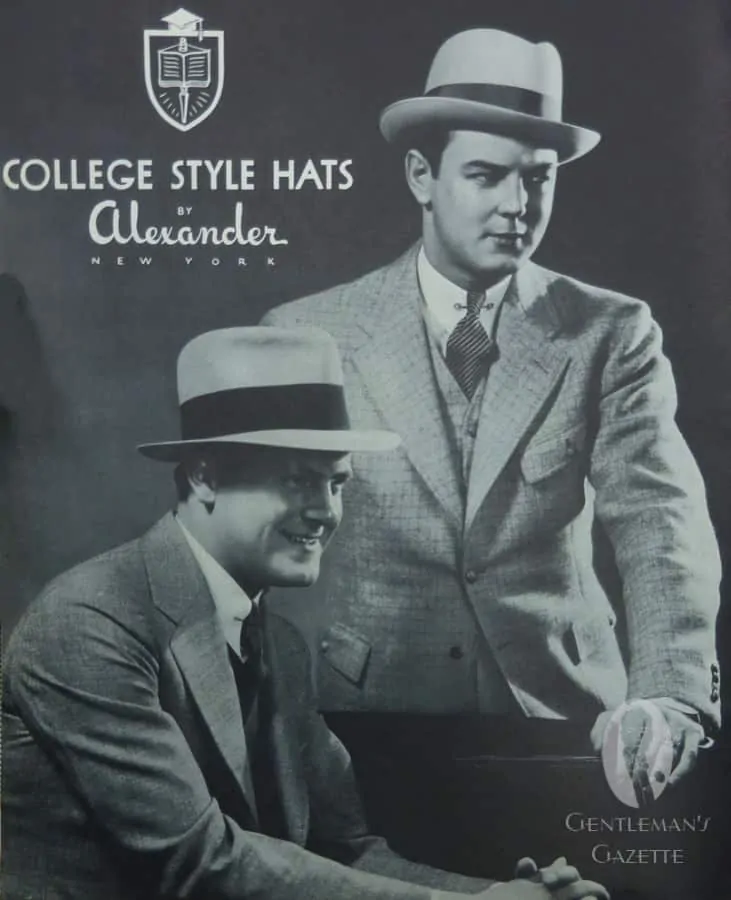
Other manufacturers like Alexander just tried to promote their style, in this case the college hat style of course. On the left we see a fedora with a high crown, a pinch and a snap brim. On the left, we can can see an elegant Homburg hat. Note, both men are wearing a collar pin and the pockets of the gent on the right feature flaps & leather buttons – including the chest pocket!
Interwoven Socks & Bostonians Shoes
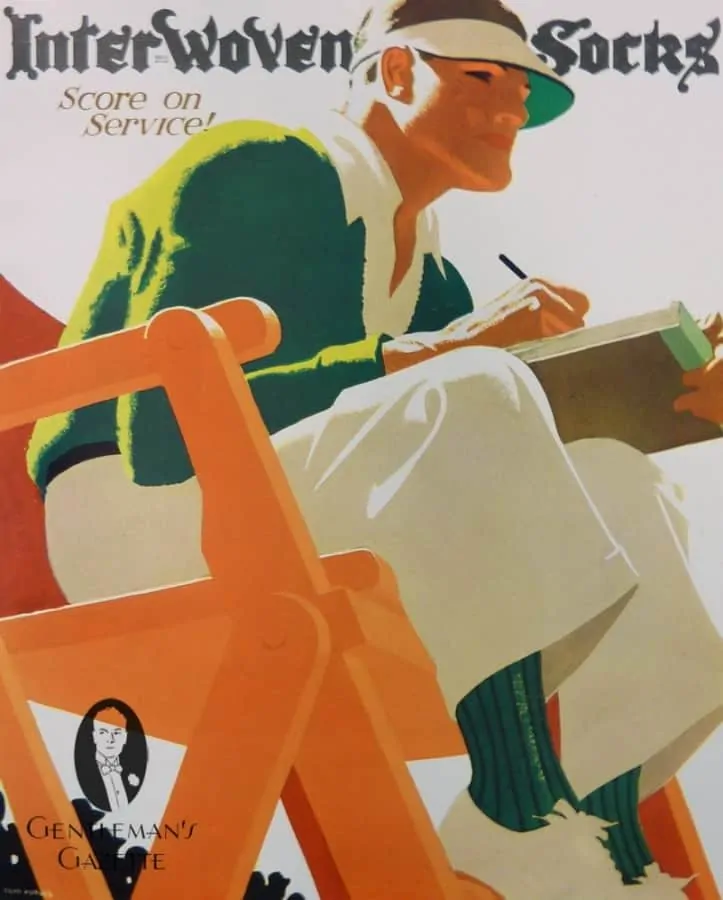
Interwoven used to be a big sock manufacturer in the US. I like this ad because it is more simplistic than the others yet not less expressive. For example, the look on the face reminds me of beaus of the 1920’s but the full cut trousers are clearly a fashion of the 1930’s. The color scheme is narrowed down, so the slacks, shoes, shirt and cap look the same and green socks can pop out. Personally, I am a great fan of these shadow stripe socks, especially if they harmonize with another part of the outfit.
Bostonians introduce walnut brown shoes for fall, that don’t need to break in. The cost per shoe was $6.50 – 8.50. The workmanship of these shoes looks quite good compared to many shoes offered nowdays. This video, explains how a shoe like this used to be made.
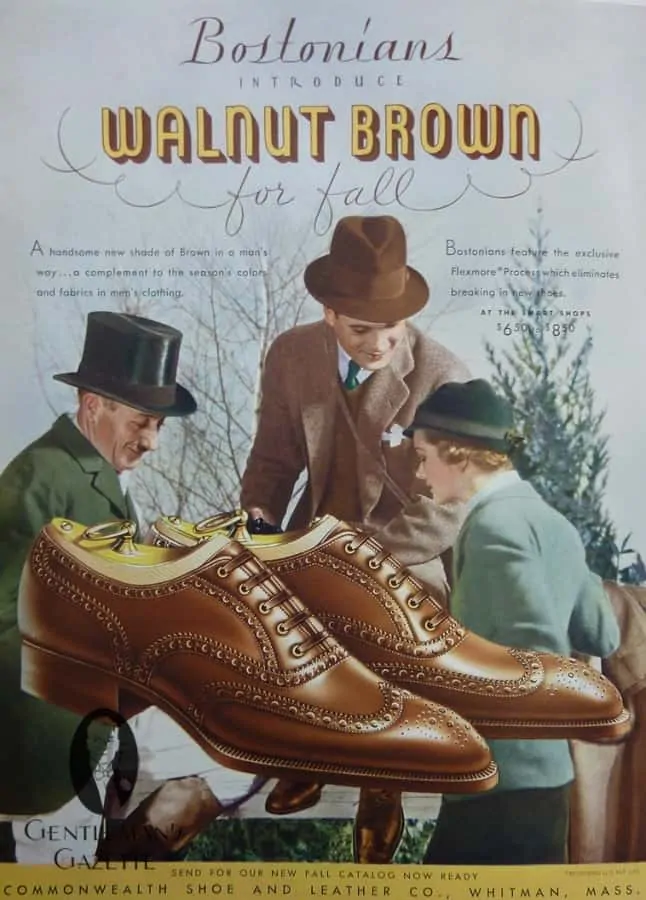
Conclusion
Overall, I would say the 1930s fashion ads were more informative and also a bit more romanticized than their modern counterparts. It is definitely a pity that the ratio of photography to fashion illustrations is basically 1:0 but I don’t think this will change again. Also, while Ivy League student were trendsetters and quite debonair, most elite students nowadays look more like Mark Zuckerberg: flip flops, jeans and hoody – that’s definitely a decline in clothing culture! What do you think? Why has the college clothing culture deteriorated so dramatically in the past decades?
Men’s Fashion Illustration Guide
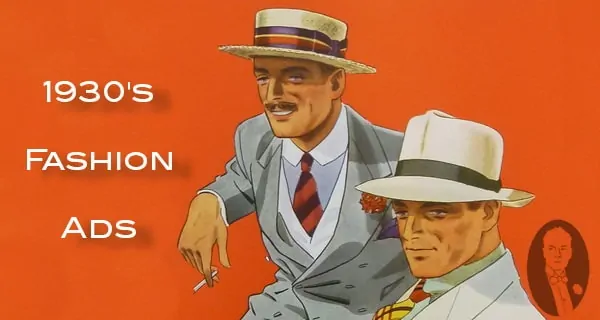
I’m a big fan these ads, where did you come across them? @aspiringgent.co.uk
O Gane, thanks for your comment. American Magazines such as Apparel Arts and Men’s Wear.
Blame it on the silicon valley corporate culture that encouraged students to dress like the new multi-billionaire. Nothing – as we unfortunately know – succeeds like success.
Which brings me to the next point … Comfort is not only overrated, but misconstrued also. Comfort is not a function of clothing, rather that of being at peace with your inner self; and its outwardly presentation
Don’t you think this development started even before Silicon Valley had such an influence?
Interesting article. Always fun to see the old advertisements.
One slight nit to pick regarding the Oxford cloth shirt: it is actually commonly referred to as the OCBD, for Oxford Cloth Button Down. A quick check of OCBD versus OBDC via Google will verify this.
BTP, thanks for pointing out the typo. It now stands corrected!
These ads are the history of how men saw themselves during that period. I wish that the men would take back this time, because today the elegance of men dressing has almost gone. It is nothing any better than seeing a well-groomed polish dressed man. My father and his brothers would take a trip to Miami & New York to shop for their shoes and custom suits when I was a little girl. They were wearing seesucker suits then Wing tip shoes, fingernails were lighlt poliish with clear polish. Shoes were always shined, hair cuts weekly, hats worn as a sign of a man being well dressed.Thanks to that era. I would like to use those pictures on some of my writings. Let me know.
“Why has the college clothing culture deteriorated so dramatically in the past decades”?
GiBills, Babby boom,60s counterculture.
The guilty is World War II.
My Uncle was Robert Goodman whom you can see did illustrations for Apparel Arts. Very
famous illustrator in 1930’s and 1940’s….He died suddenly at 37 from Walking Pneumonia
in June 1947. I am so thrilled to read the article about him on your website.
Vicki